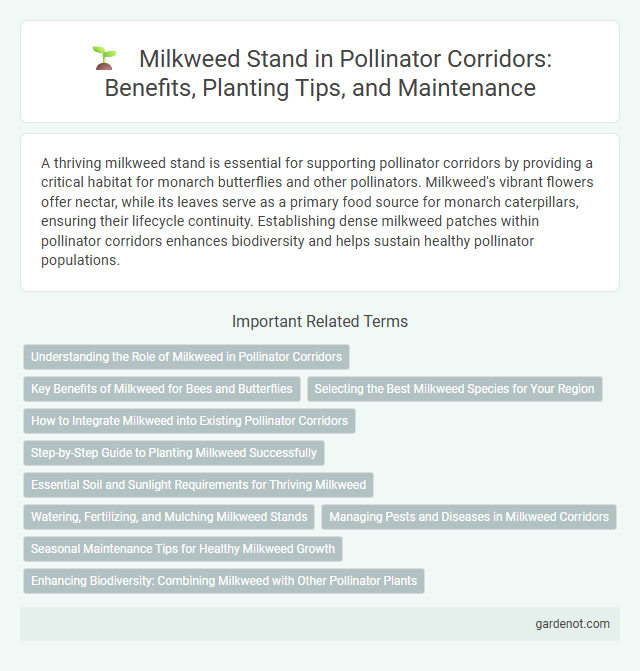A thriving milkweed stand is essential for supporting pollinator corridors by providing a critical habitat for monarch butterflies and other pollinators. Milkweed's vibrant flowers offer nectar, while its leaves serve as a primary food source for monarch caterpillars, ensuring their lifecycle continuity. Establishing dense milkweed patches within pollinator corridors enhances biodiversity and helps sustain healthy pollinator populations.
Understanding the Role of Milkweed in Pollinator Corridors
Milkweed serves as a critical host plant for monarch butterflies, providing essential habitat and nourishment within pollinator corridors. Its presence supports a diverse range of pollinators, including bees and other butterfly species, by offering nectar sources and breeding grounds. Establishing robust milkweed stands enhances pollinator biodiversity and promotes ecological connectivity across fragmented landscapes.
Key Benefits of Milkweed for Bees and Butterflies
Milkweed stands provide critical nectar sources that support the energy needs of both bees and butterflies, especially monarchs during their migration. The plant's unique structure offers essential breeding habitat for monarch caterpillars and serves as a pesticide-free environment for pollinators. By sustaining diverse pollinator populations, milkweed contributes to ecosystem stability and enhances crop pollination efficiency.
Selecting the Best Milkweed Species for Your Region
Selecting the best milkweed species for your region is crucial to support local pollinator populations effectively. Native milkweed varieties such as Asclepias syriaca in the Northeast, Asclepias tuberosa in the Midwest, and Asclepias fascicularis in the West provide optimal habitat and nectar sources for monarch butterflies and other pollinators. Understanding regional climate, soil type, and local pollinator preferences ensures the establishment of a thriving milkweed stand within the pollinator corridor.
How to Integrate Milkweed into Existing Pollinator Corridors
Incorporating milkweed into existing pollinator corridors enhances habitat diversity and supports monarch butterfly populations by providing essential larval host plants. Select native milkweed species suitable for the local climate and soil conditions to ensure successful establishment and growth. Planting milkweed in clusters along corridor edges or within wildflower mixes optimizes pollinator access and facilitates the movement of various pollinating insects.
Step-by-Step Guide to Planting Milkweed Successfully
Select a sunny location with well-drained soil to establish a thriving milkweed stand, as this environment supports optimal growth and pollinator activity. Prepare the soil by removing weeds, loosening the top layer, and enriching it with organic compost to provide essential nutrients for milkweed seedlings. Sow milkweed seeds either by direct planting in fall or early spring after cold stratification, then water consistently to maintain moist soil without waterlogging to ensure successful germination and growth.
Essential Soil and Sunlight Requirements for Thriving Milkweed
Milkweed thrives in well-drained soils with a neutral to slightly acidic pH, typically between 6.0 and 7.0, ensuring optimal nutrient uptake for robust growth. Full sunlight exposure, requiring at least six hours of direct sun daily, is critical to maximize photosynthesis and flowering essential for pollinator attraction. Incorporating sandy loam or loam soil types enhances drainage and root development, promoting healthy milkweed stands within pollinator corridors.
Watering, Fertilizing, and Mulching Milkweed Stands
Watering milkweed stands requires consistent moisture levels, especially during the establishment phase, to support robust root development and flowering. Fertilizing with a balanced, slow-release fertilizer high in phosphorus encourages strong growth and increases nectar production, vital for pollinator attraction. Applying organic mulch around the base helps retain soil moisture, suppresses weeds, and regulates soil temperature, promoting healthier milkweed growth and sustainability within the pollinator corridor.
Managing Pests and Diseases in Milkweed Corridors
Effective pest and disease management in milkweed corridors is crucial for sustaining monarch butterfly populations by preserving their primary host plant. Integrated pest management techniques, including biological controls such as introducing beneficial insects and applying organic treatments, help minimize chemical pesticide use that can harm pollinators. Regular monitoring for common threats like aphids, fungal infections, and milkweed beetles ensures early intervention, maintaining the health and vitality of milkweed stands within pollinator corridors.
Seasonal Maintenance Tips for Healthy Milkweed Growth
Regularly remove competing weeds around the milkweed stand to reduce nutrient competition and promote vigorous growth during the growing season. Monitor for aphid infestations and apply insecticidal soap early to prevent damage to milkweed leaves and stems. Cut back dead or diseased foliage in late fall to improve air circulation and support healthy regrowth in the spring.
Enhancing Biodiversity: Combining Milkweed with Other Pollinator Plants
Integrating milkweed stands with diverse pollinator plants such as goldenrod, coneflowers, and asters creates a rich habitat that supports a wide range of pollinators including monarchs, bees, and butterflies. This biodiversity fosters ecosystem resilience by providing continuous bloom periods and varied nectar sources, essential for sustaining pollinator populations throughout the growing season. Strategic planting of milkweed alongside complementary native species enhances genetic diversity and promotes balanced ecological interactions within pollinator corridors.
Milkweed stand Infographic

 gardenot.com
gardenot.com